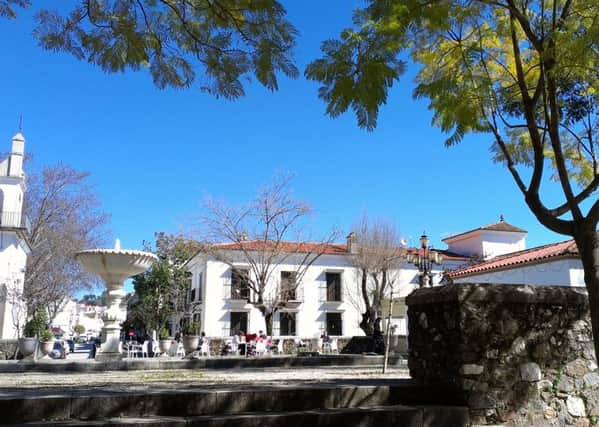Travel review: Andalucia


he Spaniards chatted noisily, ignoring both the “Silence!” and “No photos” signs as they posed for pictures in front of the shrine of the Virgen del Rocio, glimmering in her cream, pink and gold brocade dress.
The binoculars we had used to look at the pink flamingoes on the waters outside the cathedral in the surreal town of El Rocio, came in handy for examining the Holy Mother’s pale porcelain cheeks and the tiny orb and sceptre carried by Baby Jesus. The Virgin’s allure is such that she draws 1m people to El Rocio for a religious pilgrimage every May.
Advertisement
Hide AdAdvertisement
Hide AdBut now the town, which sits at the head of the Madre, a deep channel of water in the Donana national park, with its sandy streets of balconied houses and hitching posts, straight out of a modern Western – maybe a Quentin Tarantino – was shut up, immaculate, still.
The town and its excellent tapas was an unexpected highlight of a trip to Andalucia via Brittany Ferries, crossing a surprisingly calm Bay of Biscay. In our quest to bask in sunshine we headed bullet-straight from the port of Santander to Huelva province.
Our first stop was the Sierra de Aracena – a natural park of 184,000 mainly woodland covered acres.
I had dim memories of going there years earlier and there being little in the way of roads, just green hills and sleepy white villages. Now even the tiniest mountain village is easy to get to – although in a camper van you may want to avoid getting stuck by finding a parking spot before you drive in.
Advertisement
Hide AdAdvertisement
Hide AdFirst stop was Cortegana’s laid-back municipal campsite in a flower-filled meadow, on the Portugal-bound, less touristy end of the park.
If you like nature, walking and ham, you’re in the right place. The town, like many in the Sierra, dominated by a castle, is famous for being the home of the world’s most expensive jamon de jabugo – air-dried ham made from black Iberian pigs reared on acorns.
In the bars there were Andy Capp characters in houndstooth suits and women plastered in make-up in polka dot flamenco dresses breaking out into song - and it was still weeks from the outbreak of full-on fiesta season.
A trip to Almonaster la Real was idyllic. It is home to Spain’s oldest and tiniest mosque, and martins, newly arrived from Africa, were darting in and out of the arches in the prayer hall.
Advertisement
Hide AdAdvertisement
Hide AdThe next day, Sunday, everyone seemed to have decided en masse to go for a walk in the sunshine to Castano del Robledo, a mountain village, full of noble, battered mansions. It is approached as its name “castano” suggests, through woods of heavily pollarded, sweet chestnut, like Daleks with pointy branches sticking out at odd angles from their bulbous bodies. Planted in the 16th century, Huelva’s chestnut output is turned into everything from a jam to a liqueur.
On the way to the coast is the town of Las Minas de Rio Tinto - the rusty red river which lent its name to the same company that ran the Capper Pass smelter near Hull. Mountains, valleys and entire villages have been swallowed up in pursuit of iron copper, silver and a host of other mineral ores, leaving a surreal landscape of vast craters.
At the Museo Minero, the state carriage in use by the firm until 1973 and originally built for Queen Victoria, is on display, complete with porcelain sinks, toilets and sturdy mahogany chairs.
We drove past a newly reopened copper mine (estimated reserves 123 million tonnes) and walked through the orange groves to the Pena del Hierro mine, over 150m deep, known for its pure seam of iron. It still trickles blood red water into a gory reservoir.
Advertisement
Hide AdAdvertisement
Hide AdCadiz was the final destination. We stopped in Puerto de Santa Maria over the water, an old town which has seen better days and which has the highest unemployment in Spain. It has only kept 15 trawlers out of a fleet of 300, has miles of empty dock and a gritty town centre, with shops like Don Euro, the Spanish equivalent of Poundland.
Cadiz’s highlight was its central market with a great frozen swordfish being dragged in on ropes, and an opportunity to sip sherry and try yet more tapas in a convivial spot.
Hours can be spent wandering the labyrinthine 4,000-year-old city and its ancient fortifications, and walking out to the castle of San Sebastian on the breakwater. As we left a tremendous thunderstorm broke out, as if great lumps of stone were clattering down. But it all added to the atmosphere.
GETTING THERE
Brittany Ferries (brittany-ferries.co.uk/holidays/winter-sun) has just launched a range of winter sun holidays, to beat the summer shivers in Britain. Starting from just £427 per person, the packages to Spain and Portugal include overnight return cruise with en-suite cabin and four weeks accommodation in one of 27 sunshine resorts, from the Algarve to the Costa del Sol. There are nine additions to the menu this year and there’s also a location on the French Côte d’Azur, with return sailings to France from either Plymouth, Portsmouth or Poole.